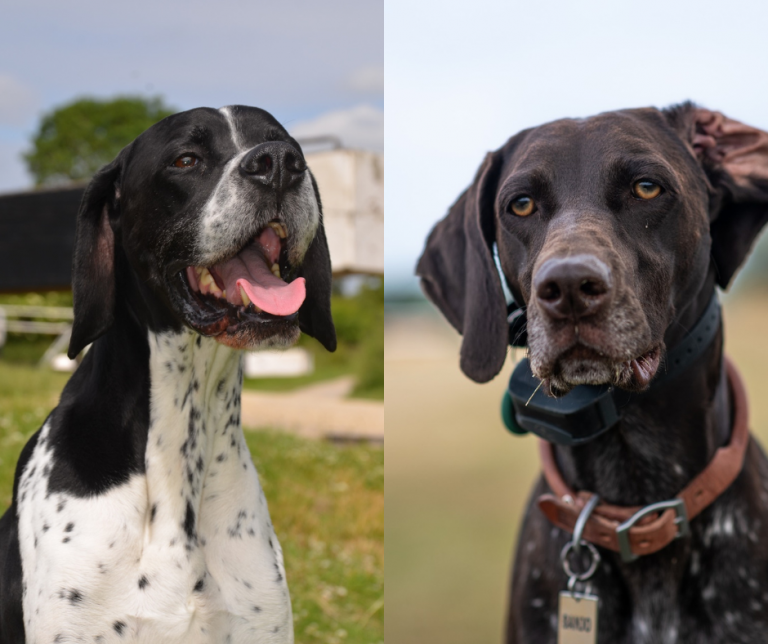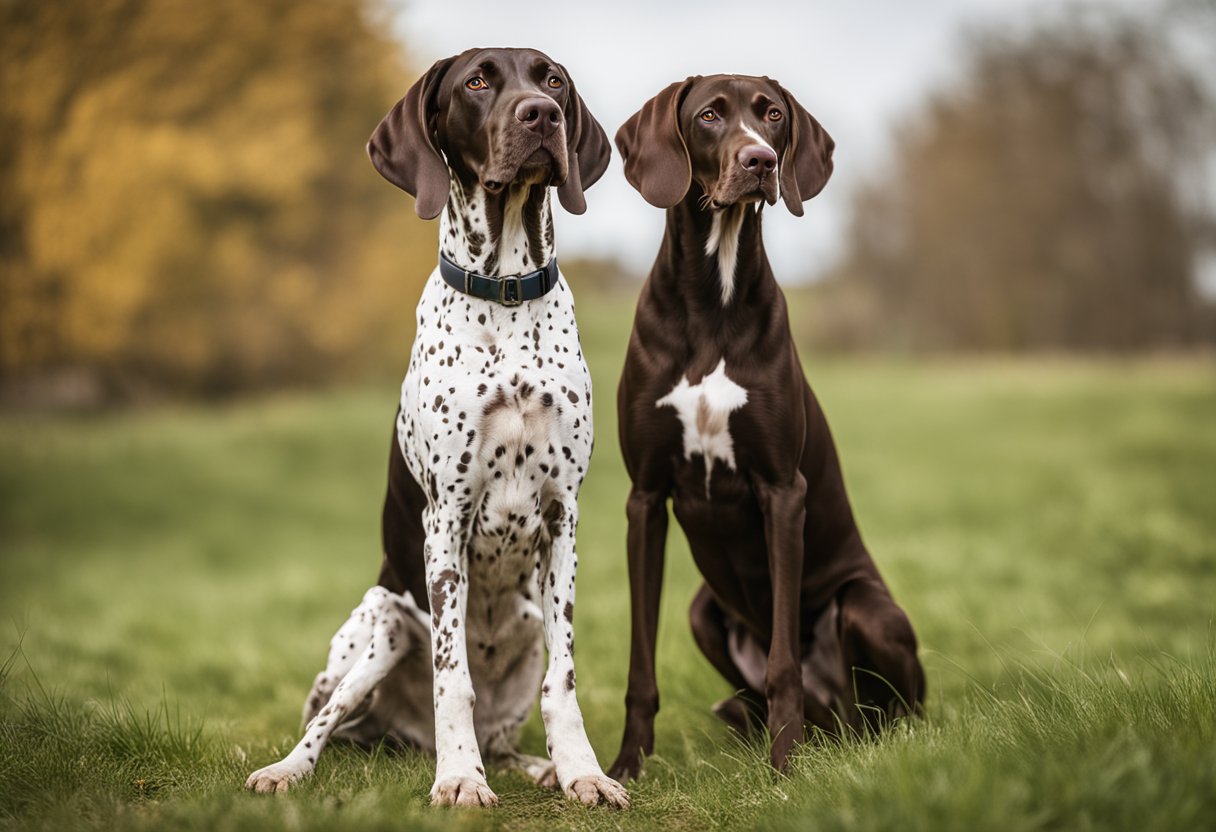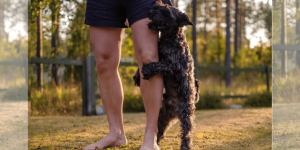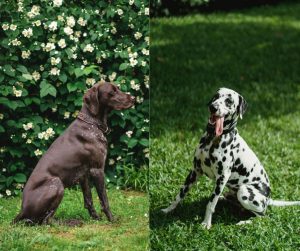When considering the ideal pointing breed for hunting or companionship, the English Pointer and German Shorthaired Pointer often come to mind. Both breeds boast a rich heritage as versatile gun dogs, expert in locating game with a staunch, statuesque pointing position. English Pointers are distinguished by their distinct hunting style and larger stature, typically standing between 26–28 inches tall and weighing in at 65–75 pounds. These dogs exhibit a keen sense of smell and a strong pointing instinct, making them exceptional in the field.
The German Shorthaired Pointer, on the other hand, presents a more compact frame, generally measuring 21–25 inches in height and weighing between 45–60 pounds. This breed is well-regarded for its multipurpose capabilities, being adept in both pointing and retrieving across various terrains. They feature a unique coat pattern, often ticked with black or liver markings, unlike the English Pointer, which tends to have more solid markings.
While both breeds are short-haired and require minimal grooming, there is a difference in their shedding patterns. The German Shorthaired Pointer is known to shed regularly and more heavily during certain times of the year. Prospective owners must consider these factors alongside the breeds’ exercise needs, temperament, and training requirements when making an informed decision on which breed best aligns with their lifestyle and expectations.
Today, we will look at temperament, training, appearance, and health comparison of English Pointer vs German Shorthaired Pointer. From the windswept British moors to the vast American fields, the English Pointer and German Shorthaired Pointer embody centuries of hunting dog refinement. But within that shared passion lies a world of difference.
Breed Origin and History
The heritage of the English Pointer and the German Shorthaired Pointer reveals each breed’s unique development tailored to specific hunting needs in their countries of origin. Both have become renowned for their capabilities in the field and as companions.
English Pointer Origins
Originated in England in the 17th century, the English Pointer’s ancestry includes a diverse mix of dogs, primarily Spaniels and Italian Pointers. These dogs were bred to point gamebirds by standing still and directing hunters to their quarry. Over time, their breeding was refined, enhancing their natural instincts and stamina for hunting in the wide-open countryside of England.
German Shorthaired Pointer Origins
The German Shorthaired Pointer (GSP) originated in Germany in the 19th century. Designed to be versatile hunters, their ancestry likely incorporates Spanish Pointers, bloodhounds, and track and trail dogs. The first standard for the GSP was adapted from the original German standard and approved in America in 1946. They were bred to hunt in Germany’s varied landscapes, from dense forests to open fields, and they possess qualities that serve them in both land and water retrieval.
Physical Characteristics
When looking at the English Pointer vs German Shorthaired Pointer appearance comparison, it is evident that while both breeds exhibit athletic builds suitable for hunting, they possess distinct physical traits that differentiate one from the other.
Size and Build
The German Shorthaired Pointer (GSP) is characterized by a well-balanced and muscular body. They tend to have a deep chest and strong loin, indicative of their power and stamina. Typical male GSPs stand between 23 to 25 inches tall at the shoulder, while females are slightly smaller, ranging from 21 to 23 inches. In terms of weight, males weigh in at about 55 to 70 pounds, with females averaging 45 to 60 pounds.
The English Pointer, on the other hand, exhibits a graceful and athletic frame that’s slightly finer-boned compared to the GSP. Males generally stand between 25 to 28 inches and weigh between 55 to 75 pounds, and females stand between 23 to 26 inches, weighing slightly less.
Coat and Color
Both breeds have short coats, but the texture and color may vary. The German Shorthaired Pointer typically has a short and thick coat, often spotted or patched in liver and white. The coat is designed to protect the dog in rough outdoor conditions while also being easy to maintain.
In contrast, English Pointers also have a short coat, but it tends to be less dense. The breed standard encompasses a variety of colors including lemon, liver, black, and orange, with or without white. Both breeds are considered low-maintenance when it comes to grooming due to their short coats.
Distinctive Features
Distinctive to the German Shorthaired Pointer are its floppy ears, set high on a well-defined head, and a tail typically docked to about 40% of its original length in regions where it is legally permitted. The GSP’s physical appearance oozes a sense of purpose and agility.
The English Pointer is renowned for its noble head and expressive, even-tempered ears. Its overall physical appearance is one of alertness and dignity, with a particularly poised carriage of the head enhancing its profile against the hunting landscape.
Temperament and Personality
The German Shorthaired Pointer and the English Pointer both exhibit distinct temperaments and personality traits that suit active families and hunting enthusiasts. Exploring these breeds’ behaviors and dispositions reveals a blend of intelligence, energy, and sociability, with nuances specific to each breed.
Behavioral Traits
German Shorthaired Pointers are known for their versatility and enthusiasm in various activities, matched by a vibrant demeanor. They display playful and friendly attitudes, yet can be stubborn at times. English Pointers, in contrast, are independent and more reserved, but still alert and loving. Both breeds exhibit an affectionate nature, making them excellent family pets.
Training and Intelligence
Highly intelligent and eager to please, the German Shorthaired Pointer is responsive to training. With their sharp minds and eagerness, they excel in obedience when engaged consistently. English Pointers are similarly smart but might be easily distracted due to their independent streak, requiring a patient approach to training.
Social Aspects
Both breeds thrive in social settings. German Shorthaired Pointers tend to be more affectionate and friendly towards people and other dogs. English Pointers are gentle but may be slightly more reserved, yet they still make excellent companions for children and other family pets.
Energy Levels
As high-energy dogs, both the German Shorthaired and English Pointers need plenty of exercise. The German Shorthaired Pointer is particularly active, requiring vigorous daily activities. The English Pointer, while also energetic, may have slightly less intense exercise requirements.
Hunting and Prey Drive
Both breeds possess strong hunting instincts and prey drive, reflective of their heritage as bird dogs. The German Shorthaired Pointer is an all-around hunter, easily transitioning between water and land. English Pointers are skilled at locating and pointing to game, suited for hunting in open fields.
Adaptability
The adaptable nature of both the German Shorthaired and English Pointers allows them to adjust to various living conditions, provided their exercise needs are met. German Shorthaired Pointers, in particular, are known for their versatility, thriving in both active and family environments. English Pointers may favor more wide-open spaces due to their hunting background.
Exercise Requirement
Both the German Shorthaired Pointer (GSP) and the English Pointer are breeds known for their high energy levels and need for ample exercise. They thrive on physical activity and require substantial daily exercise to maintain their health and happiness.
German Shorthaired Pointers typically need between 1 and 2 hours of exercise per day. An adult GSP’s exercise regimen should include:
- Daily walks
- Vigorous activities like running or fetch
- Mental stimulation through training or sports
Engagement in activities such as swimming, running, and hiking can significantly contribute to the well-being of a GSP.
In contrast, English Pointers, while also energetic, demand similar levels of physical activity but may have slight variations in endurance or intensity preferences. Their exercise routine often consists of:
- Long, brisk walks
- Free play in a secure area
- Structured activities such as field trials or hunting
For both breeds, the lack of sufficient exercise can lead to behavioral issues. They are designed to be active working dogs and can become restless or destructive if their activity needs are not met. Proper exercise supports their physical health and mental stimulation, crucial to their overall well-being.
Training and Obedience
Training and obedience are essential in shaping the behavior and skills of both English Pointers and German Shorthaired Pointers. These intelligent breeds respond well to consistent training methods and are known for their high energy levels, necessitating regular exercise and mental stimulation.
Trainability
German Shorthaired Pointers (GSPs) are typically eager to learn and have a high level of trainability. As active and intelligent dogs, they pick up on commands quickly, making them relatively easy to train. On the other hand, English Pointers are also smart, but they can sometimes be more independent in nature, which may require a more patient approach to training. Consistent and positive reinforcement techniques work well for both breeds.
Obedience and Discipline
For obedience, both the German Shorthaired Pointer and the English Pointer require firm and consistent discipline. They are energetic breeds that thrive on attention and structured training sessions. Regular practice of obedience exercises enhances their self-control and ability to follow commands, which is crucial for their role as field dogs. You can go a long way by combining training and exercise together. For example, try agility training.
Socialization
Early socialization is imperative for these pointers to develop well-rounded temperaments. Introducing these dogs to various environments, people, and other dogs at a young age helps them become more adaptable and less prone to anxiety. The GSP, with its friendly nature, typically enjoys socializing, while the English Pointer may require more encouragement to develop strong social skills.
Hunting Capabilities
When it comes to hunting, both breeds exhibit outstanding capabilities as hunting companions due to their high intelligence and stamina. The German Shorthaired Pointer is versatile in the field, often used for retrieving and tracking. The English Pointer, with its keen sense of smell and strong pointing instincts, excels in locating game birds. Regular training enhances their natural abilities, making them reliable and responsive partners in hunting situations.
Health and Care
When considering the health and care of the German Shorthaired Pointer (GSP) and the English Pointer, it is important to address their potential health issues, maintenance of their coat through grooming, their specific dietary needs, and exercise requirements to maintain a healthy lifestyle.
Common Health Issues
Both the German Shorthaired Pointer dogs and the English Pointers are generally healthy breeds with a life expectancy of around 12-15 years. However, they are prone to certain hereditary conditions. The GSP may be susceptible to hip dysplasia, a malformation of the hip joint that can lead to arthritis. Additionally, bloat, a life-threatening condition where the stomach distends and may twist, is a concern for both breeds. Progressive retinal atrophy, which can lead to blindness, as well as cone degeneration, are eye conditions to be aware of, particularly with the GSP.
Grooming and Shedding
Both the GSP and the English Pointer have short coats, which require minimal but consistent grooming. Brushing once a week can help control shedding and keep the coat healthy. The German Shorthaired Pointer tends to shed more heavily, especially seasonally, thus may require more frequent brushing.
Diet and Nutrition
A balanced diet is critical for maintaining a healthy weight and supporting the high energy levels of these active breeds. Both breeds may benefit from high-quality commercial or home-prepared food (under veterinary supervision). Special attention should be given to portion sizes and meal frequency to prevent bloat.
Exercise for Well-being
The GSP and the English Pointer are high-energy dogs that require regular exercise to stay mentally and physically fit. Along with daily walks, these breeds thrive on having a job to do, such as hunting or participating in canine sports. Exercise not only helps to ward off health issues related to inactivity, such as obesity, but also helps to manage their energy levels and reduce the chance of behavioral problems.
Lifestyle Consideration
When considering English Pointers and German Shorthaired Pointers, prospective owners should evaluate the breeds’ suitability as family pets, their compatibility with active lifestyles, and adaptability to various living environments.
As Family Pets
English Pointers and German Shorthaired Pointers are both affectionate and friendly, making them popular choices for family pets. They are known for their loyal and loving nature, often forming strong bonds with family members. While German Shorthaired Pointers may exhibit a slight edge in trainability, both breeds require consistent socialization from a young age to develop well-rounded temperaments.
- English Pointer:
- Temperament: Affectionate, Social
- Training: Responsive, Requires Patience
- German Shorthaired Pointer:
- Temperament: Loyal, Intelligent
- Training: Highly Trainable, Eager to Please
For Active Owners
Owners who lead an active lifestyle will find a perfect companion in either breed. Both are athletic and high-energy dogs, necessitating regular exercise to maintain their physical and mental well-being. Choosing between the two often comes down to personal preference.
- Exercise Needs:
- English Pointer: Extensive daily exercise
- German Shorthaired Pointer: Frequent vigorous activities
In Different Living Environments
Both the English Pointer and the German Shorthaired Pointer can adapt to various living environments, with some considerations. While they can live in apartments, a spacious home with a yard is ideal. Regarding tolerance to being left alone, individual dogs may differ, but neither breed should be left isolated for extended periods.
- Housing Preferences:
- English Pointer: Adapts well, but needs space to move
- German Shorthaired Pointer: Best with access to a yard for exercise
Breed Comparisons
The English Pointer and the German Shorthaired Pointer are both revered hunting dogs with distinct qualities. Their comparison reveals varied suitability in hunting, differing exercise needs, and how well they integrate into family life.
English Pointer vs. German Shorthaired Pointer
Size: The English Pointer dog breed typically stands between 26-28 inches tall and weighs 65-75 pounds. In contrast, the German Shorthaired Pointer usually measures 21-25 inches in height and weighs 45-60 pounds.
Coat and Coloring: German Shorthaired Pointers often have ticked coats with black or liver markings, while English Pointers tend to display more solid colorations.
Suitability as Hunting Dogs
English Pointer: Renowned for their keen sense of smell and proficiency in locating birds, English Pointers excel in the field.
German Shorthaired Pointer dogs: These canines are versatile hunters and are well-adapted to both land and water. They are active dogs with a high energy level perfect for various hunting scenarios.
Exercise and Activity Needs
- English Pointer: They require ample daily exercise to satisfy their high energy levels
- German Shorthaired Pointer: This breed is similarly active and needs plenty of exercise and engagement to prevent boredom
Family and Social Compatibility
- Intelligence and Trainability: Both breeds are intelligent and trainable, but the German Shorthaired Pointer might have a slight edge in trainability due to its eagerness to please
- Family Pet: When it comes to being a family companion, German Shorthaired Pointers are generally more adaptable to family life and can make a slightly better family dog due to their affectionate nature. However, with proper training and socialization, English Pointers can also be wonderful family pets
Breed Popularity and Availability
Now that we talked about English Pointer vs German Shorthaired pointer, let’s talk about availability. In America, the popularity of dog breeds can fluctuate based on factors such as trends, breed characteristics, and the dogs’ suitability to families and living conditions. When considering the German Shorthaired Pointer (GSP) and the English Pointer, both breeds possess qualities that make them favored choices for certain households and hunters, impacting their popularity and availability.
The GSP tends to rank higher in popularity in the United States. This is reflected in the American Kennel Club’s (AKC) list of most popular breeds, where the German Shorthaired Pointer usually occupies a spot within the top 20. Their versatility in hunting and adaptability as family pets contribute to their widespread appeal.
The English Pointer, while not as high on the AKC’s popularity list, still holds a significant place among hunting breeds. Their availability might be less compared to their German counterparts, but they remain a commendable choice for their specialized skills in bird hunting and their dignified demeanor.
Availability of both breeds generally correlates with their popularity. Breeders for the GSP are more readily found across the country, while those for the English Pointer might be fewer, necessitating a more targeted search for potential owners.
| Breed | AKC Popularity Ranking | Relative Availability |
|---|---|---|
| German Shorthaired Pointer | Top 20 | Widespread |
| English Pointer | Lower than GSP | Less Widespread |
Both breeds are evident in shelters and rescue groups, offering alternative avenues for those looking to welcome these dogs into their homes. It’s recommended that prospective owners research thoroughly to identify reputable sources when considering adoption or purchase.









